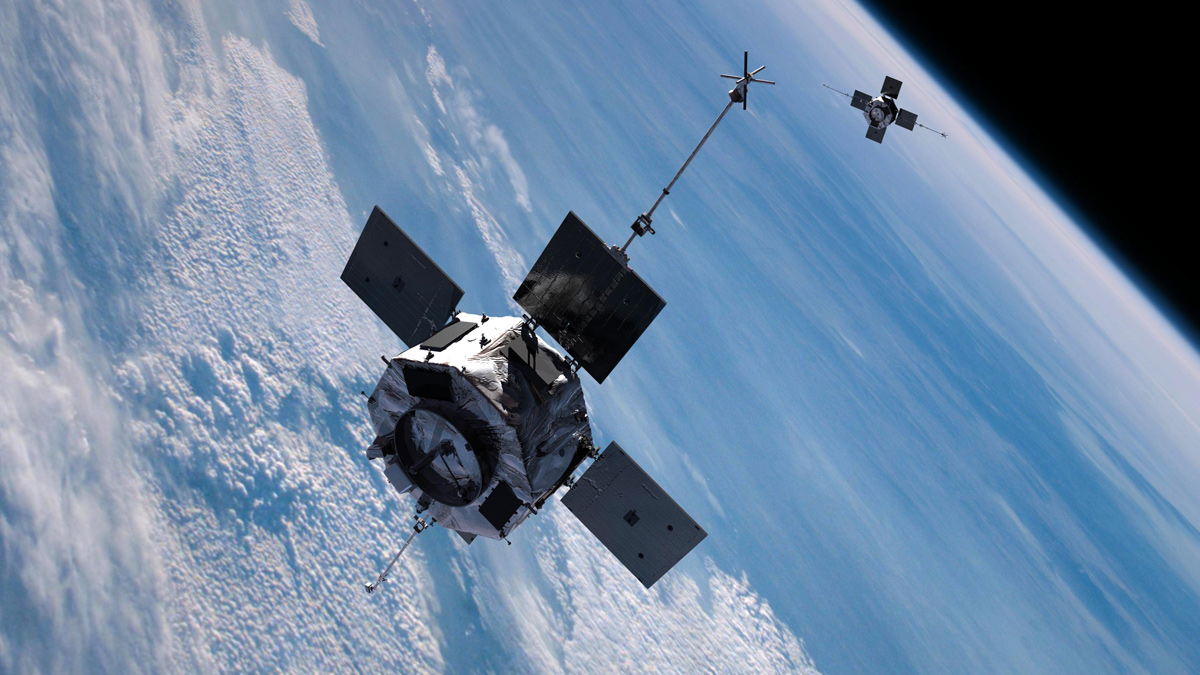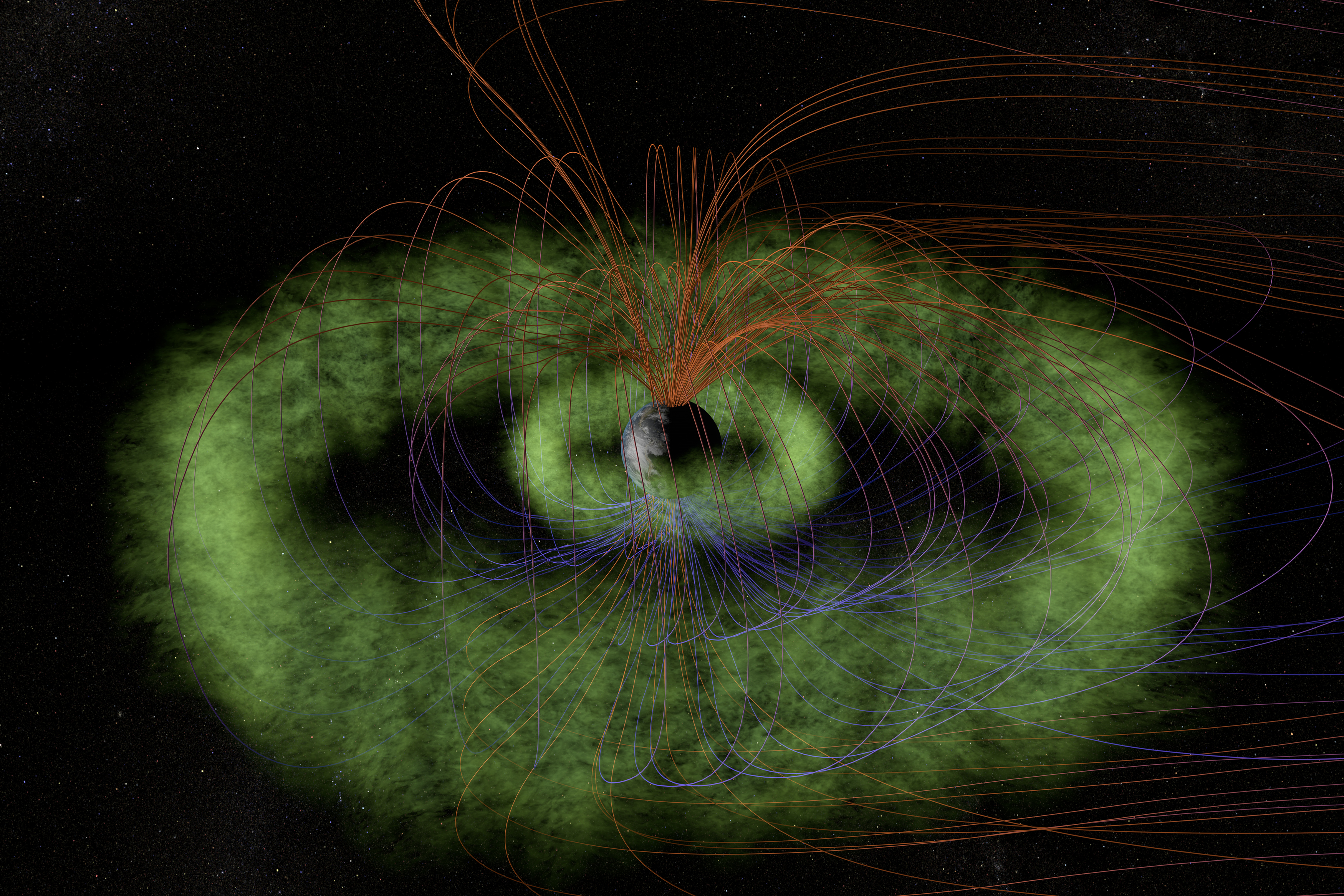NASA Launching Twin Space Probes Into Earth's Radiation Belts Friday

Two NASA radiation probes are poised to launch into orbit early Friday (Aug. 23) on a mission to explore some of the harshest, most hazardous regions of space, the Van Allen Belts.
Although scientists have known of the existence of the radiation belts for more than half a century, many of the details still puzzle them — details that the twin Radiation Belt Storm Probes should help to clarify. Liftoff is set for Friday at 4:07 a.m. EDT (0807 GMT) atop an Atlas 5 rocket from a pad at Florida's Cape Canaveral Air Force Station.
Extending up to 25,000 miles (40,000 kilometers) around the Earth like a giant doughnut, the Van Allen Belts contain highly energized particles capable of penetrating metallic satellites — or the softer human tissue of astronauts in space.
Ejections from the sun —dangerous enough on their own — can create a shockwave that bends the radiation belts toward Earth, accelerating quick-moving particles even faster. The resulting onslaught can damage power grids, disrupt satellites and GPS and threaten passengers aboard high-flying planes. [Video: Probes to Study Radiation Threat]
The $686 million Radiation Belt Storm Probes (RBSP) mission will help scientists to understand more about the chaotic regions overhead. The invisible particles within the belts make even determining their shifting size a challenge.
"In order to measure them, you have to fly through them with sensitive instruments," Berry Mauk, RBSP project scientist, told SPACE.com.
However, radiation levels within the belts are constantly changing, and scientists aren't completely certain of why.
Get the world’s most fascinating discoveries delivered straight to your inbox.
"If you can't answer simple questions, you can't even begin to hypothesize why that radiation suddenly went up," Mauk said.
Fast, slow, high, low
Most of the particles trapped in the Van Allen Belts stream in from the sun, though some come from cosmic rays in space. Bouts of high solar activity can accelerate or boost the contents of the radiation belts, but similar events don't always cause the same reaction.
A coronal mass ejection — a large, fast-moving collection of particles shot from the sun toward Earth — might cause phenomenal auroras and damage power transistors one day, while a similar assault months later might have only minimal effects.
The reason for the differences isn't clear, but it's one question that RSBP hopes to find some answers to. To do so, the two crafts will travel to the heart of the radiation belts to study how the various types of particles are distributed.
The belts contain electrons and protons at various energy levels, as well as heavier particles of ionized oxygen and helium. Hot plasma also surrounds the Earth, ionized gas that puts out only a few tens of volts. The plasma travels in waves, and when it encounters the other particles, it affects their motion.
"Think about plasma waves like sound waves in the atmosphere," Mauk said.
"Those plasma waves exchange energy with very high-energy radiation particles."
Some of the particles are accelerated by their contact with the plasma, while others lose energy.
RBSP also intends to study how the different particles move through the space around Earth. As they stream from the sun into the Van Allen Belts, they get caught by the magnetic field lines and begin to spiral around them, accelerating.
But the belts don't capture all of the particles. Some hit the field lines at just the right angle, rebounding into space or into the Earth's atmosphere in what scientists call "bounce motion." Other particles may drift around the Earth itself, moving from the day to night side. The higher energy particles move faster than their lower energy cousins, making it possible to reconstruct the event that originally energized the particles.
"It's a very complicated interchange between low-energy, medium-energy and high-energy particles, and we have to measure all of those," Mauk said.
Riding the waves
Named for James van Allen, the scientist who discovered them with the flight of Explorer 1, America's first satellite, in 1958, the Van Allen Belts are in a constant state of flux, growing and shrinking as they are affected by space weather. In order to make more detailed measurements, the Radiation Belt Storm Probes will use two twin satellites following identical paths, sometimes zipping just above Earth's atmosphere and sometimes thousands of miles out.
Traveling through both the inner and outer radiation belts, the crafts will maintain varying distances, sometimes within 100 miles of one another, at other times able to fit three Earths between them. [How the Radiation Belt Storm Probe Mission Works (Infographic)]
Their separation will allow scientists to get a better feel for changes that occur in the belts. One craft may absorb a spike in radiation levels. What the second craft reads from a different location will reveal a great deal about what is happening in the belts.
It may read a similar increase. It may only detect the higher levels when it reaches the same region the first craft was traveling through. It may pick up the spike after a slight delay, indicating that the radiation is traveling, wavelike, through the belts. Or it may see nothing at all.
In addition, RBSP contains the most comprehensive suite of instruments flown into the radiation belts.
"It's very hard to make quality measurements in the heart of the region," Mauk said. He explained that, because the radiation is constantly bombarding the instruments, it can be difficult to separate out the data from the noise. RBSP is using several backups on its instrument to ensure clean readings.
Earth isn't the only planet in the solar system with radiation belts. Though very different, both Jupiter and Saturn boast bands of charged particles around them. And X-ray and radio astronomy missions record high radiation regions all over the universe, in places such as the Crab Nebula. So in addition to helping protect astronauts, satellites and sensitive electronics, RBSP can also lend insight into more distant locations.
"We're using Earth's radiation belt as a natural laboratory here so we can understand the creation of radiation regions elsewhere in the solar system, and elsewhere in the universe," Mauk said.
You can follow NASA's launch of the Radiation Belt Storm Probe mission live on NASA TV beginning at 1:30 a.m. EDT here: http://www.nasa.gov/ntv
This story was provided by SPACE.com, a sister site to LiveScience. Follow SPACE.comon Twitter @Spacedotcom. We're also on Facebook & Google+.

Nola Taylor Tillman is a contributing writer for Live Science and Space.com. She loves all things space and astronomy-related, and enjoys the opportunity to learn more. She has a Bachelor’s degree in English and Astrophysics from Agnes Scott college and served as an intern at Sky & Telescope magazine. In her free time, she homeschools her four children.





